Subcity 30 Year Rewind – KLF Interview (3 November 1995)
The following article offers notes and context for one of the first Subcity broadcasts, the KLF Interview from 1995. Words by Ed Strutt, host of Medium Wave.
To commemorate the 30 year anniversary of this broadcast, there will be a special episode of Subcity Rewind on Monday 3 November 2025 at 10pm, where we will re-broadcast the interview in full.
The KLF (1987-1992)
The KLF were an electronic music band formed of Scottish musician, Bill Drummond and English musician, Jimmy Cauty. Within club culture, they are favourably remembered as pioneers of the Ambient house sound through their 1990 LP ‘Chill Out’: seen by many as the first ambient record that helped shape the signature downtempo sound of the Chill Out room of the 1990’s, where tired-out clubbers would lie horizontally and enjoy the last embers of an MDMA high together.
The seminal ‘Telepathic Fish’ ambient parties were among those that truly perfected the chill-out room, creating a relaxing space where the LP was enjoyed. Held in a South London squat during the early 90’s, the parties were regularly soundtracked by event organiser DJ Food, with Aphex Twin once a guest DJ under his Caustic Window moniker.
Tracing the KLF’s career takes you in all sorts of strange and unusual directions, and musical dots are joined in unlikely places. Bill Drummond was a shrewd individual with years of experience within the music industry, including as the manager of Echo and the Bunnymen during the 1980’s. Together as the KLF, he and Jimmy Cauty wrote three number one hits including maximalist rave anthem ‘3AM Eternal’ (1991) and the novelty record ‘Doctorin’ The Tardis’ (1988)’ as ‘The Timelords’.
There was often a level of tongue in cheek humour in their music, the KLF even self-published a book titled ‘The Manual (How to Have a Number One the Easy Way)’ which very much pointed to a cynicism towards the formulaic structure of pop music at the time. By 1992, they announced their retirement from the music business and deleted their entire back catalogue with immediate effect.
K Foundation
After retiring from music, the KLF set up an Art Foundation called ‘K Foundation’ which was a non-musical platform for the KLF’s artistic output post-retirement. The activities of the K Foundation would see Drummond and Cauty egging each other on in to pull off increasingly extravagant pranks in a way that often aimed to disrupt or at least comment on the booming art world in London.
In the early 90’s, “Young British Artists” (YBAs) as they were then known saw artists like Damien Hirst and Tracey Emin enjoy meteoric rises within the art world, partly by financial backing of advertising mogul Charles Saatchi. During the Subcity broadcast, Drummond reveals his criticism of this group of artists by saying that their output ‘just isn’t good enough’.
‘YBA’ sculptor Rachel Whiteread won the Turner Prize in 1993 for her artwork ‘House’. The work featured a full-size house in plaster, on the edge of Wennington Green Park in Bow, East London.
In the run up to the Prize ceremony, Situationist style posters appeared around London. This campaign, created by the K Foundation appeared to attempt to subvert the then booming British art world. One of those posters (pictured below) sees the K Foundation flipping the notion of the Turner prize on its head by letting the people choose which nominee was ‘The Worst of them All’. The Turner prize winner would then have to collect £40,000 by midnight, and if they didn’t, the K Foundation would burn the money on the steps of the Tate Modern. Whiteread, perhaps unsurprisingly, saw the whole thing as an imposition, and reluctantly collected the money with minutes to spare, announcing the proceeds would go towards a charitable cause.
The K foundation reached its cultural zenith on August 23 1994 when Drummond and Cauty burned £1,000,000 of their own money in £50 bank notes in an abandoned boat house on the Isle of Jura. They filmed the entire burning process and produced a film titled ‘The K Foundation Burn a Million Pounds’. During the Subcity broadcast, Drummond’s reveals that his friend Gimpo believed that had they been able to burn the £40,000 on the steps of the Tate Modern, they may not have gone all in and burnt the £1,000,000.
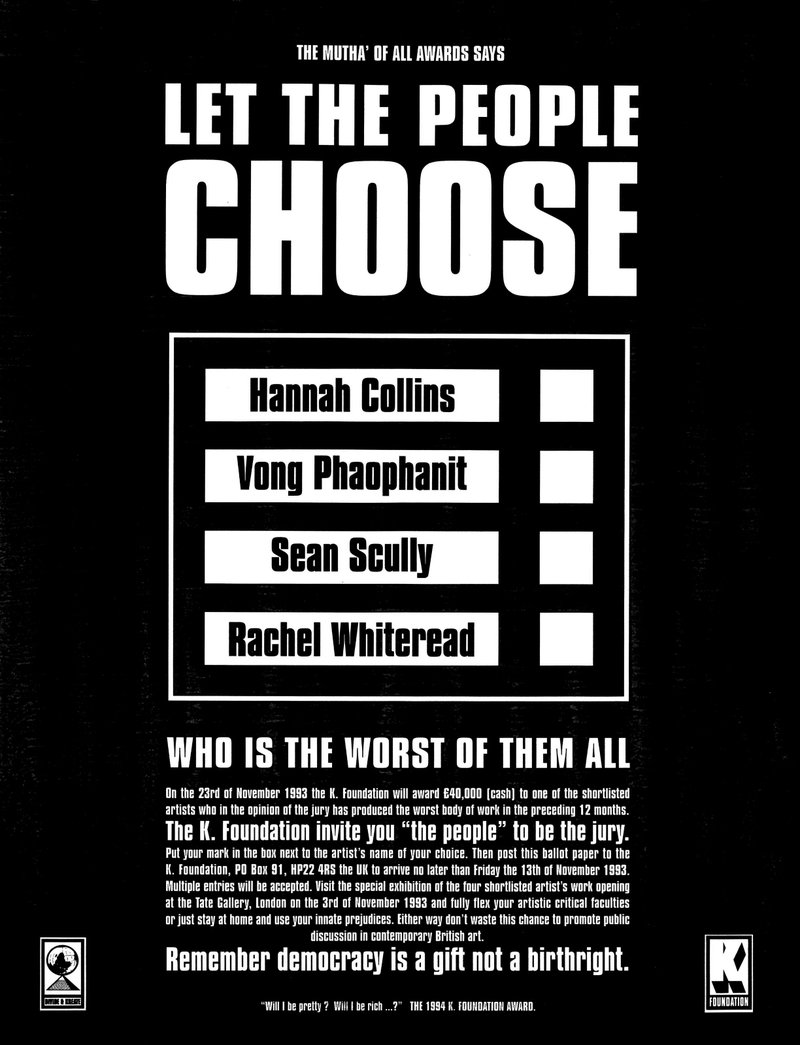
1993 Poster from the K Foundation.
While less extreme, the 1990’s British art world of the time seemed to thrive off a similar camaraderie and anarchic spirit. Visual artists were pushing the limits of taste, and challenging the status quo, but they were also backed by the establishment. Although the K Foundation’s MO can be seen as a critique of contemporary art, it is easy to wonder if Cauty and Drummond, in some way, assumed that their dark and nihilistic prankster act would court attention and interest from the art world. Drummond even suggests in the Subcity broadcast when speaking to Andrew Nairne of Scottish Arts Council that they ‘would have been taken more seriously had [they] burnt the money in a gallery’.
The K Foundations’ film of the burning is available online, and whilst it’s doubtful that many have sat through its entirety, the burning did see the KLF (although technically dissolved at that time) gain infamy and recognition. The film/act has arguably still failed to have achieved any artistic or philosophical merit. Drummond’s former protégé Julian Cope was unimpressed, claiming that Drummond still owed him money. “He burned a million pounds which was not all his, and some of it was mine. People should pay off their creditors before they pull intellectual dry-wank stunts like that.”
KLF Interview on Subcity FM - November 3 1995
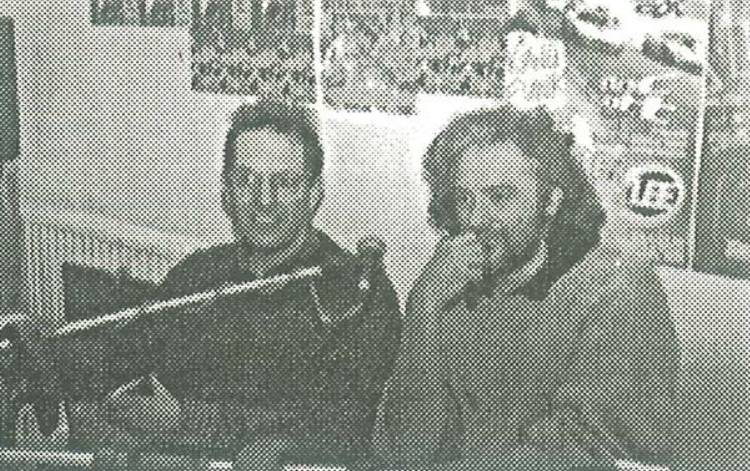
Bill Drummond (left) and Jimmy Cauty being interviewed on Subcity Radio.
"November 3 1995, a mews cottage tucked away in a lane high above Glasgow's Kelvingrove park. In what should be a bedroom is squeezed an 8-track mixing desk, turntables, CD players, piles of records, microphones and a DAT player. On the roof is a transmitter broadcasting a signal to roughly 30 square miles of the city.” Show host John Dower recounting the broadcast in a zine titled Thee Data Base (released in March 1996), the article also included sections from the transcript which you can read in full below.
In this rare broadcast from Subcity’s FM era, John Dower and Dave Greer, hosts of the show ‘Everything you Know is Wrong’ are joined by K Foundation’s Jimmy Cauty and Bill Drummond. Earlier that day, the pair had shown their film ‘K Foundation Burn a Million Quid’ to a group of manual workers at Royal Exchange Glasgow, which would shortly become the Gallery of Modern Art (GoMA).
The show hosts invite journalist Jack McClean and Andrew Nairne, of the Scottish Arts Council, to ask the pair questions surrounding their burning of £1,000,000. Both Mclean and Nairne reflect the outrage of the public and indifference of the art world. Whilst there is interesting discussion throughout the show and plenty of good-humoured banter between the hosts and the guests, a slight frustration from Cauty and Drummond is perceptible at points.
Interestingly, on 5 November 1995 - two days after this episode was broadcast, Bill Drummond and Jimmy Cauty signed a contract agreeing to end The K Foundation for a period of 23 years. They further indicated they would not speak about the burning of the million pounds during the period of this moratorium. This marks a critical point within the KLF/K-Foundation’s history that may well have been lost in time if it hadn’t been posted on to SoundCloud by Stuart Buchanan.
Why did they burn the money?
It’s hard to understand why anyone would want to burn a million pounds. In interviews since, Cauty has expressed regret for doing so. Speaking in archive footage from around the time, Cauty says of the burning ‘Every day I wake up, I’ve got to live with the fact I’ve burnt a million quid and no one thinks it’s art, everyone just thinks it’s a waste of time’. (from 2021 documentary film ‘Who Killed the KLF?’)
Burning money isn’t generally understood as a radical act and common reactions generally range from bemusement to moral outrage, questioning why someone wouldn’t give the money to charity instead. Whilst the explanations given by Drummond and Cauty are far from coherent, the pair stood by their action and often alluded to a belief that the act of burning £1,000,000 was an attempt to achieve something far too esoteric for the understanding of the general public.
Strangely enough, there is an active community dedicated to burning money in the UK, though they aren’t burning anything close to the value of £1,000,000 in 1994 (roughly £2.5 million in today’s money). ‘The Church of Burn’ in 2024, held an event ‘Summer Solstice Burn’ as part of We Don’t Know What This Is (WDKWTI). On their website, they draw attention to the impossibility of their existence: a church dedicated to the ritual destruction of money, in a society where its rule is persistent, and frame their activity as reclaiming a sense of power against this. The website also mentions magic as the ‘creative source of the material world’ and infinite in possibility, which very much chimes with interpretations of KLF’s burning on Jura in 1994.
In his book KLF: The Band that Burned a Million Quid’ (2013) John Higgs suggests the pair burnt the money ‘to see what would happen’ in a kind of open dialogue with the universe, a ‘magical act’. Higgs also suggests that in doing so Drummond and Cauty are thought to have sought the cleansing of their souls after selling them to a corrupt music industry. In the absence of a satisfactory explanation from the KLF, we must draw our interpretations by considering the dissonance between the formulaic music industry’s predictability and the band’s desire for radical subversion.
References:
The KLF: Chaos, Magic and the Band who Burned a Million Pounds (2013) Written by John Higgs
‘Who Killed The KLF? (2021) Directed by Chris Atkins
Church of Burn’s website: Accessible at: https://churchofburn.org/
Article from 'Thee Data Base' (dated March 1996)

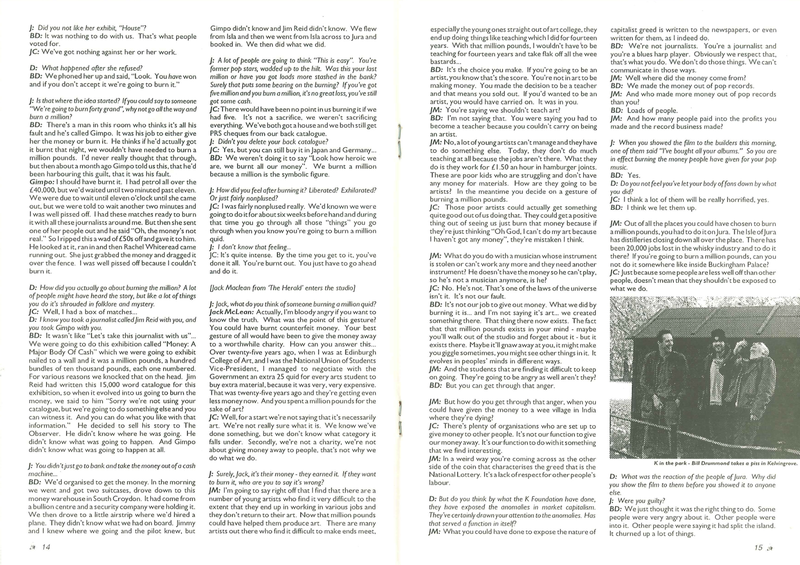
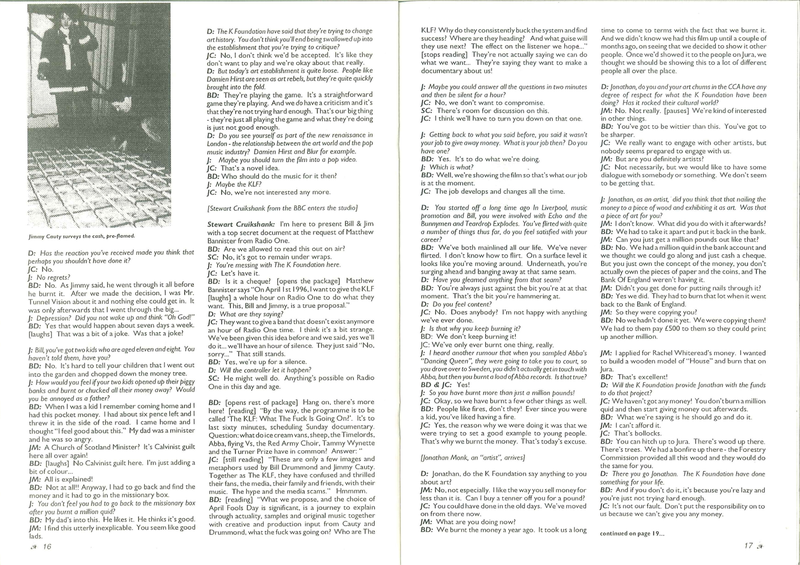
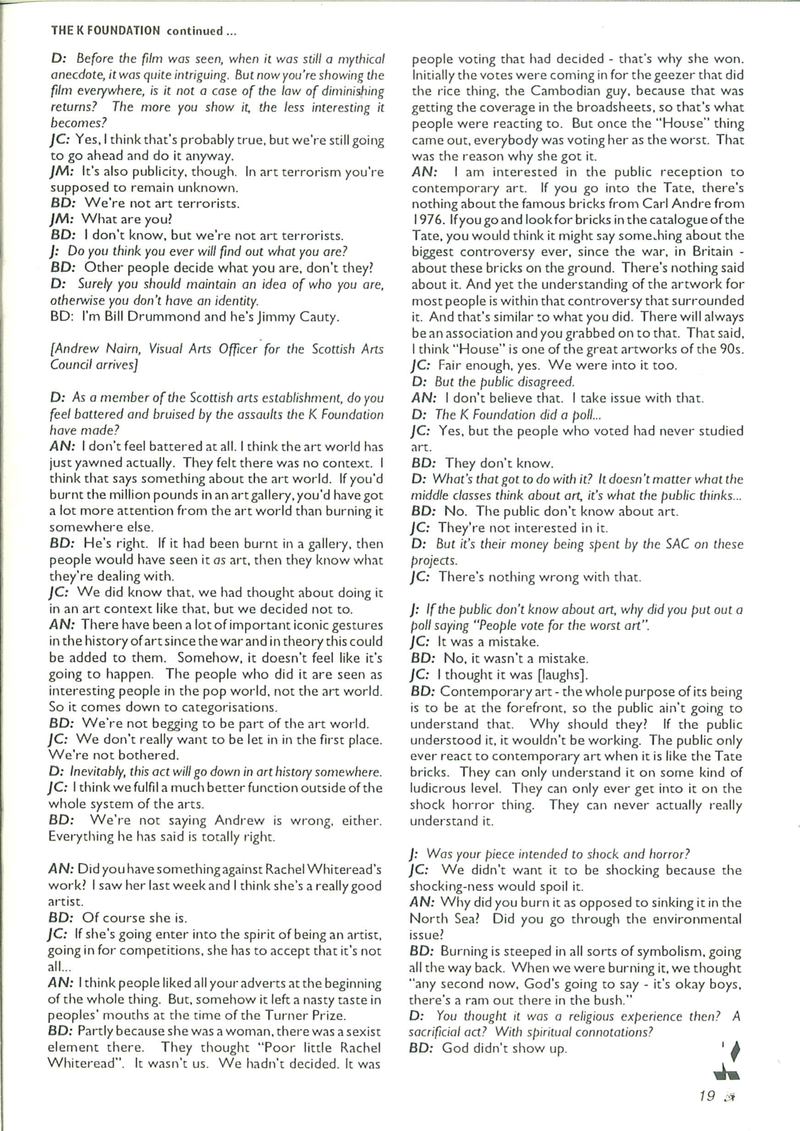
With thanks to Stuart Buchanan for providing the above zine article as well as the recording of original broadcast.



 listen back
listen back
